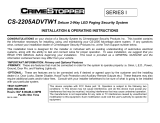
Contents
Warning! safety first ..........................................................................................5
What is included ...............................................................................................7
Installation points to remember ............................................................................7
Virtual Tach ..............................................................................................7
The control center .....................................................................................8
Valet® program switch ..............................................................................8
Status LED ................................................................................................8
Doubleguard shock sensor .........................................................................9
Before beginning the installation .................................................................9
After the installation ..................................................................................9
Component locations and finding wires .............................................................10
Making your wiring connections .......................................................................10
Primary harness (H1), 12-pin connector .....................................................11
Auxiliary harness (H2), 8-pin connector .....................................................11
Heavy gauge remote start, (H3) 10-pin connector .......................................12
Remote start input, 5-pin connector ...........................................................12
Remote start auxiliary output, 5-pin ...........................................................12
Door lock harness, 3-pin connector ...........................................................13
Wire connection guides ...................................................................................14
Primary harness (H1) ...............................................................................14
Auxiliary harness (H2)
................................................................. 18
Heavy Gauge, 10-pin connector ...............................................................22
Remote start input - 5-pin connector ...........................................................24
Door lock wire diagrams .........................................................................26
Neutral safety switch interface ..........................................................................27
Testing the neutral safety switch ................................................................27
Plug-in LED and valet/program switch ................................................................28
Bitwriter interface - 3-pin black plug ..................................................................28
Optional sensor port - 4-pin connector ...............................................................28
Tachometer settings .........................................................................................29
Virtual tach ............................................................................................29
Tach learning .........................................................................................30
Tach threshold On/Off ............................................................................30
D2D Jumper settings ........................................................................................31
Setting the light flash polarity ............................................................................31
Impact Sensor Adjustment ........................................................................32
Remote control Learn Routine™ .........................................................................34
Remote Control Programming ...................................................................34
Remote control configuration ............................................................................37
Responder LC 2-way ...............................................................................37
System features learn routine ............................................................................38
Feature menus ................................................................................................41





















